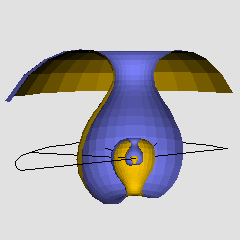

 |
We show a discrete constant mean curvature (in fact, minimal) net of revolution in hyperbolic 3-space (in its Poincare half-space incarnation).
Two virtually antithetic approaches to the study of discrete surfaces of constant mean curvature are the variational approach (as employed in the Electronic Geometry Model [12], for example) and the integrable systems approach (as employed in the Electronic Geometry Model [6], for example). Here we follow the second approach, where discrete quadrileral nets are considered. In particular, we consider discrete cmc nets as special discrete isothermic nets, where each elementary quadrilateral has concircular vertices and any four quadrilaterals satisfy a cross ratio factorizing condition ("wide definition" of discrete isothermic nets).
A definition of constant mean curvature for such nets is known (see [2], [3]) when the ambient space is Euclidean 3-space, and it generalizes in a canonical way to the cases where the ambient spaces are spherical 3-space or hyperbolic 3-space via an application of the Calapso transformation [7]. However, in hyperbolic 3-space, only the cases of constant mean curvature H with |H| greater than or equal to 1 could be defined using this method [5]. A new compatible definition has recently been given in [4], using a notion of conserved quantities for discrete isothermic surfaces, that also extends to the case |H| less than 1 for the hyperbolic ambient space. The enclosed model shows the discrete counterpart of a minimal surface of revolution in hyperbolic space from [1], i.e., one of the previously inaccessible discrete surfaces.
Smooth minimal and constant mean curvature surfaces of revolution in hyperbolic 3-space are known. Explicit formulas for them were found in [8], where their stability properties were studied. As noted above, such minimal examples were also examined in [1], where relations to Willmore surfaces were considered. Many new examples of minimal surfaces in hyperbolic 3-space, both periodic and nonperiodic, were found in [9], [10], [11], and these works include hyperbolic minimal catenoids with topologically different realizations, either of annular or disk type, depending on the choice of rotation symmetry.
Our construction of a discrete hyperbolic minimal catenoid uses a geodesic axis that is pointwise fixed under the rotation symmetry, thus we have a catenoid of annular type, not disk type. It is a surface of revolution periodically traversing between the upper and lower half-space models of hyperbolic 3-space, in the same way that the smooth counterpart seen in [1] does.
It is an important task to find explicit examples of discrete constant mean curvature surfaces, although it is difficult to construct discrete constant mean curvature surfaces with given mean and ambient curvatures in general. However, we have developed an explicit construction method in the case of discrete equivariant surfaces of revolution, where the equations become simpler. Starting from these surfaces, more examples can be obtained by applying discrete Baecklund transformations (see [4]).
More specifically: a discrete isothermic net comes canonically with a family of discrete connections on an attached (discrete) vector bundle. Such a net is said to be a discrete cmc net if it has a family of parallel sections which is linear with respect to the (spectral) parameter; the parallel section encodes the ambient space form and the mean curvature sphere of the net in the usual Moebius geometric way. We can then construct discrete (equivariant) nets of revolution in a given space form and for a given mean curvature: we start from an initial meridian edge (which has to satisfy a reasonable open condition on its position) and construct a mean curvature sphere at both endpoints of the edge (in an almost unique way: there is a choice of two, depending on the solutions of a quadratic equation); then, prescribing a discrete analogue of the hyperbolic arc length of a curve, we obtain a unique propagation of the meridian curve and its attached mean curvature spheres. The surface is then obtained by (arbitrary) discrete rotations about the designated axis. The reader is referred to [4] for the details of the construction.
Here we show graphics of a discrete minimal surface in hyperbolic 3-space, constructed from the linear conserved quantities approach. Also, included is a Mathematica program, which can be used to construct discrete constant mean curvature surfaces of revolution, with various values for the mean curvature and for all three of the space forms (Euclidean, spherical, hyperbolic 3-spaces).
Model produced with: JavaView v3.95
| Keywords | discrete constant mean curvature surface; surface of revolution; Euclidean 3-space; spherical 3-space; hyperbolic 3-space | |
| MSC-2000 Classification | 53C42, 53A10 (37K35, 37K25) |
Submitted: Wed Apr 23 11:19:00 CEST 2008.
Accepted: Mon Nov 29 09:35:32 CET 2010.
University of BathWayne Rossman
Department of Mathematical Sciences
University of Bath
Bath, BA2 7AY
United Kingdom
u.hertrich-jeromin@maths.bath.ac.uk
http://www.maths.bath.ac.uk/~masuh/
Kobe University
Mathematics Department
Faculty of Science
Rokko, Kobe 657-8501
Japan
wayne@math.kobe-u.ac.jp
http://www.math.kobe-u.ac.jp/HOME/wayne/wayne.html